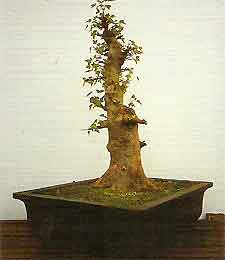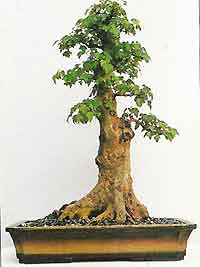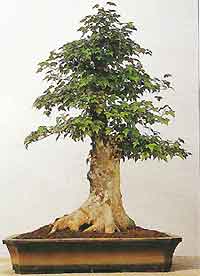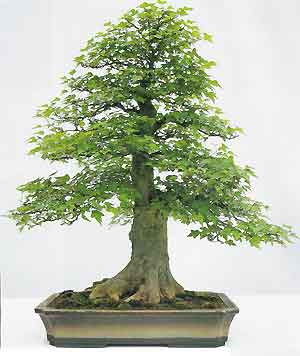Bonsai Trees
Case Histories
Trident Maple - (acer buergerianum)
Trident Maple Bonsai Style: Informal Upright

In the early days of establishing my collection I had many more trees than I do now. This allowed me to experiment with techniques and there was always plenty of branches to practice my wiring on!
However most of my trees were similar in size, with none having trunks of any real girth and I longed for the day when I would own a bonsai with a large trunk. I realised that the overall structure and appearance of the tree was what made a good bonsai and that 'size was not important'! However I still felt that my collection needed size variety.
A few months later I was fortunate to find a selection of trident maples for sale. The one that caught my eye was not only the largest, but needed the most work to improve it.

I had decided when beginning this hobby that on the few occasions when I would buy a bonsai tree, I would never purchase a 'finished' specimen, only one where I could really make my own mark on the tree, one with real potential that I could develop myself. I felt that this was such a tree and so purchased it with this in mind.
Trident Maple Bonsai History: Training
I proudly returned home with the trident maple and it was immediately displayed with pride of place on my bonsai bench. It somewhat dwarfed the rest of my trees, which were much smaller. After selecting a new front, I was faced with a dilemma as the branch arrangement was poor from this angle.

I could either compromise and keep the original, less attractive front and existing branch structure, or cut off all the branches and re-grow them. After convincing myself that the branches were poorly arranged anyway and had been grown too quickly, making them very straight, I decided to remove them all.
I watched the trident closely for the next few weeks, as the new buds and shoots began to appear all over the tree, in every place that I had hoped they would, and more besides. Feeding the tree heavily, I let it grow freely whilst I studied the trunk and began to decide its future shape.
Later in the year I attended a bonsai convention, where there were many inspiring trees and also lots of trade stands. I purchased a large rectangular pot that I felt would suit the trident maple admirably.
Spring arrived and it was time to repot the trident maple. The tree had an excellent root system and was beginning to get pot bound.

I needed to root prune very hard to enable the tree to be positioned correctly in its new pot. When the tree began to grow I wired and structured the branches, leaving more than were necessary whilst I decided which ones would finally be needed.
Over the next three years the tree was repotted annually and several main branches were removed, making the overall image less cluttered. The trident was allowed to grow strongly during this period so that the branches would thicken.
The tree had finally reached a stage where it needed to be completely wired. I did this during the winter when I could view its leafless structure more clearly. After being thoroughly thinned out, every single branch and twig was wired and carefully positioned. It was a day's work, but the result was well worth the effort. With its fleshy root system, the trident maple requires good winter protection, which in turn allows winter pruning to be possible.
The development of this fine trident maple has been slow and gradual. It has taken many years to reach its present structure, but my patience has certainly been rewarded.
 In the early days of establishing my collection I had many more trees than I do now. This allowed me to experiment with techniques and there was always plenty of branches to practice my wiring on!
In the early days of establishing my collection I had many more trees than I do now. This allowed me to experiment with techniques and there was always plenty of branches to practice my wiring on! I had decided when beginning this hobby that on the few occasions when I would buy a bonsai tree, I would never purchase a 'finished' specimen, only one where I could really make my own mark on the tree, one with real potential that I could develop myself. I felt that this was such a tree and so purchased it with this in mind.
I had decided when beginning this hobby that on the few occasions when I would buy a bonsai tree, I would never purchase a 'finished' specimen, only one where I could really make my own mark on the tree, one with real potential that I could develop myself. I felt that this was such a tree and so purchased it with this in mind. I could either compromise and keep the original, less attractive front and existing branch structure, or cut off all the branches and re-grow them. After convincing myself that the branches were poorly arranged anyway and had been grown too quickly, making them very straight, I decided to remove them all.
I could either compromise and keep the original, less attractive front and existing branch structure, or cut off all the branches and re-grow them. After convincing myself that the branches were poorly arranged anyway and had been grown too quickly, making them very straight, I decided to remove them all. I needed to root prune very hard to enable the tree to be positioned correctly in its new pot. When the tree began to grow I wired and structured the branches, leaving more than were necessary whilst I decided which ones would finally be needed.
I needed to root prune very hard to enable the tree to be positioned correctly in its new pot. When the tree began to grow I wired and structured the branches, leaving more than were necessary whilst I decided which ones would finally be needed.